Yinka Shonibare Brings Textile Art to SBMA
U.K. Artist Makes Fashion and Politics High Art
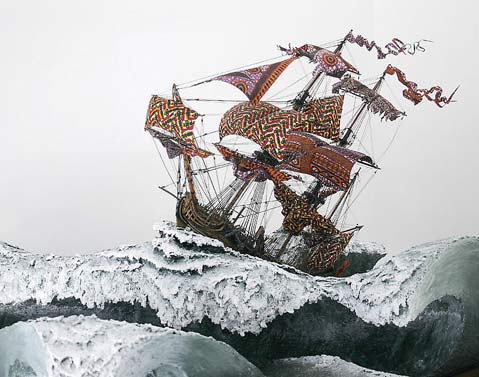
Clothing is communication. Like it or not, what we wear sends a visual message to those around us (think of the old saying, “Clothes make the man.” We recognize when someone is “overdressed” or “underdressed” for a particular event. We wear costumes at Halloween to “put on” another’s identity. Clothing sends cultural messages as well; blue jeans are associated with America, kimonos with Japan, saris with India. Yinka Shonibare’s art shows us that clothing can communicate important political messages as well.
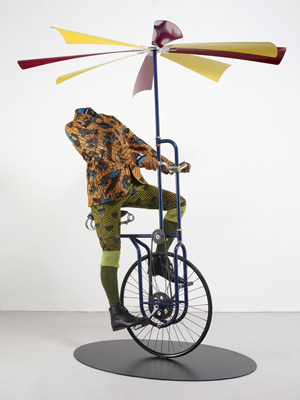
But you don’t have to be a fashion addict or a political wonk to enjoy Shonibare’s art. In fact, his art is hard to resist. Try suppressing a smile when you see A Flying Machine for Every Man, Woman and Child, a grouping of life-sized headless mannequins dressed in fancy clothes riding unicycles with whirligigs attached at the top. You can’t help being drawn to his other tableaux as well: a formally-dressed nuclear family; three brightly-coated men accompanied by their fiberglass dogs chasing a fiberglass fox; two well-dressed students sharing an old-fashioned school desk. Shonibare’s work is beautiful and enticing, even somewhat humorous. Of course, as is true of most museum-worthy art, Shonibare’s work is also embedded with layers of meaning. To really get to the bottom of it, you need to think about why his work looks the way it does.
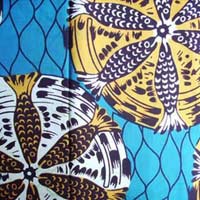
Cut from Complex Cloth
Take for example Shonibare’s mannequins, who are dressed in fashions reminiscent of 19th century Britain, though the fabric used in the clothing appears (and is) totally contemporary. Noted textile expert and Santa Barbara resident Starr Siegele explains the significance of this particular cloth, and its relevance to Shonibare’s work: “The printed fabric is a key, signifying pivot in this artist’s work. The brightly colored, sometimes amusingly patterned cotton prints certainly seem cheerful and innocent enough at first glance. But these fabrics speak on multiple levels to the role of printed cotton as one of the major commodities driving England’s triangle slave trade.” It turns out those headless dummies in the fancy getups are making a serious statement about colonialism and its unsavory effects.
According to Siegele, there’s another aspect to Shonibare’s use of this specific type of printed cotton. He buys the fabric in England, but it’s actually produced by a very old Dutch company, Vlisco. Vlisco has exported printed cotton fabric to Africa since the 19th century. In those days, the fabric designs were based on traditional Indonesian wax resist patterns. But the fabrics became so popular in Africa that the prints have become, Siegele says, “internationally synonymous with Afro-centric identity.” Shonibare himself is quite up front about his use of fabric in his art: As he told Ingrid Sischy in the New York Times in 2005, “Superficially, it seems to be African…Then you realize zilch comes from Africa. Before you stereotype people, think about it. What you see in front of you is just the surface. There are many stories behind it.”
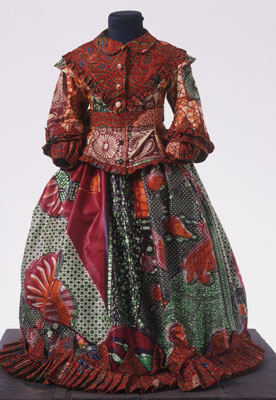
The fact that Shonibare’s mannequins wear 19th century-style fashions is also significant. The Victorian era was a time when strict moral standards were publicly espoused but often blatantly ignored in private. Sexual repression coexisted with prostitution, and children were both idealized and subject to hard labor in factories and mines. Witness the artist’s sweet group of child-sized mannequins named for three famous Victorian-era British authors: Charlotte Bronte, Emily Bronte, and Charles Dickens. Dressed in their historically correct outfits, they are adorable little dolls. But in reality, all three of these kids endured tough childhoods and ended up writing books containing depictions of children who were abused and neglected. Charles Dickens, who worked in a factory as a child, grew up to depict the horrors of child labor in Oliver Twist. The Bronte sisters wrote Jane Eyre and Wuthering Heights under assumed male-sounding names in order to have their works published in an era when women, like children, were seen but not heard.
The Masquerading Dandy
The Victorian era was also known for its rabid imperialism, when Africa was plundered by various European powers. This is especially significant to Shonibare. As he told Jenny Horrocks of the BBC in 2004, “Of course I realised, as an African, that Victorian values for me, were very draconian : The Victorians colonized Africa. Basically, the Victorian made Africans work to produce a great empire. So Victorian values to me, were values of repression, values of making me feel inferior.”
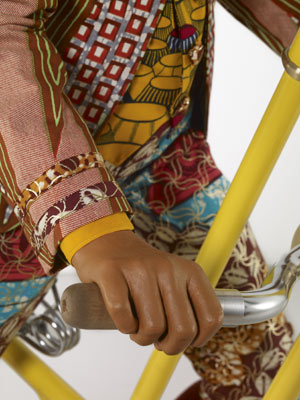
The combination of English-style fashion and African fabric also epitomizes Shonibare’s childhood growing up in two cultures that were visually expressed by clothing: “My father would go to work in a suit, but when he got back home, he would change into African robes,” he reminisced in the same New York Times interview. Shonibare himself is somewhat of a dandy, favoring custom suits created by bespoke Savile Row British tailor Richard James. But this aspect of his persona, like his art, has multiple levels. “What I like most about the concept of the dandy,” Shonibare told interviewer Anthony Downey in 2004, “is that it is the masquerade par excellence. It is a disguise where you appear to be a member of the aristocracy but you are always on the outside…The dandy’s practice takes something you are supposed to be outside of and re-appropriates it for a different use: to be subversive and challenge the establishment.”
And what about those headless mannequins? They may remind us of store windows or fashion exhibits, but there’s a historical link to be made as well. As Shonibare told Downey, it was “a kind of joke about the French Revolution and the aristocracy with their heads being taken off.” That’s quite a message.
4•1•1
Yinka Shonibare’s A Flying Machine for Every Man, Woman and Child opens at SBMA on Saturday, March 14, and runs through June 21.
In addition to docent-led tours, film screenings, and a poetry reading, there will be three lectures associated with the exhibition.
• On Wednesday, May 13, Sylvester Okwunodu Ogbechie, Associate Professor of the History of Art and Architecture at UCSB, will deliver a talk titled Renegade Insider: Cloth and Cultural Identity in the Art of Yinka Shonibare.
• On Wednesday, May 20, Lynn Gumpert, Director of the Grey Art Gallery at NYU, will speak on The Poetics of Cloth: African Textiles/Recent Art.
• And on Wednesday, May 27, Starr Siegele will give a talk called Slave to Fashion: Yinka Shonibare and Printed Textile History.
For more information, call 963-4364 or visit sbmuseart.org.



